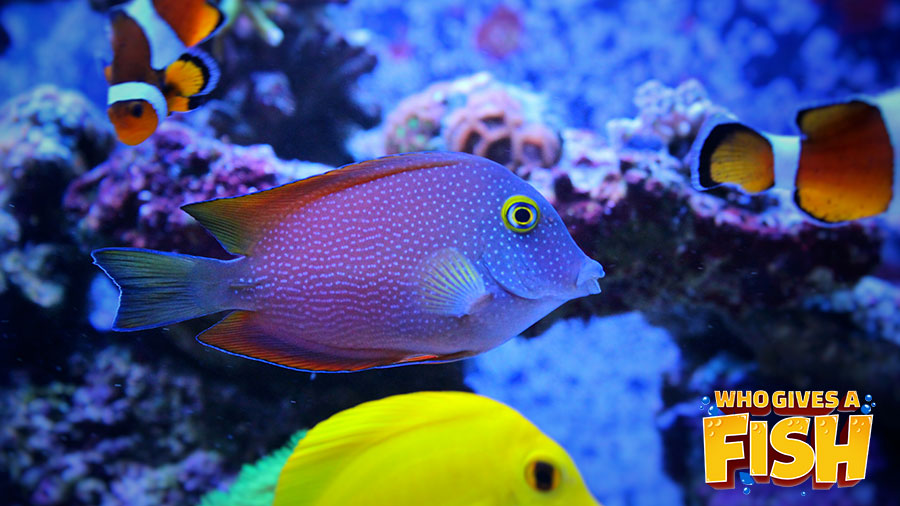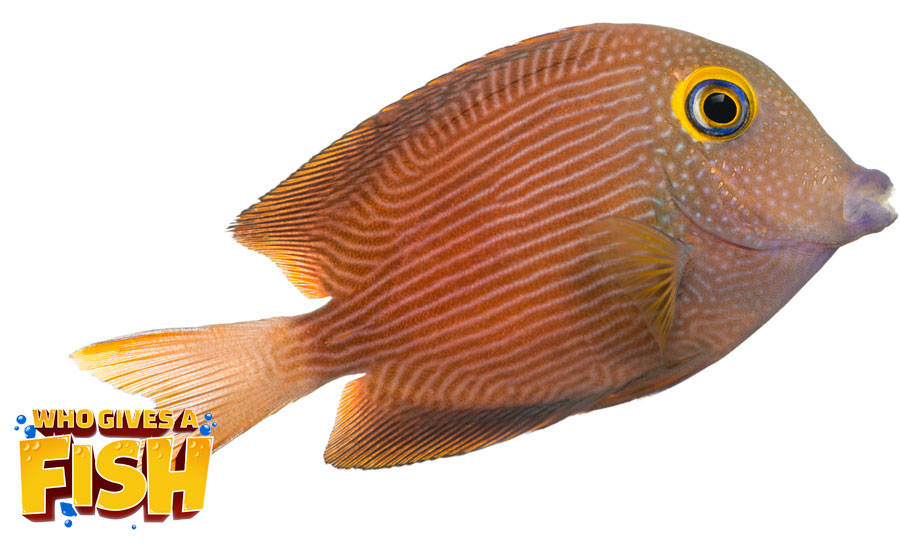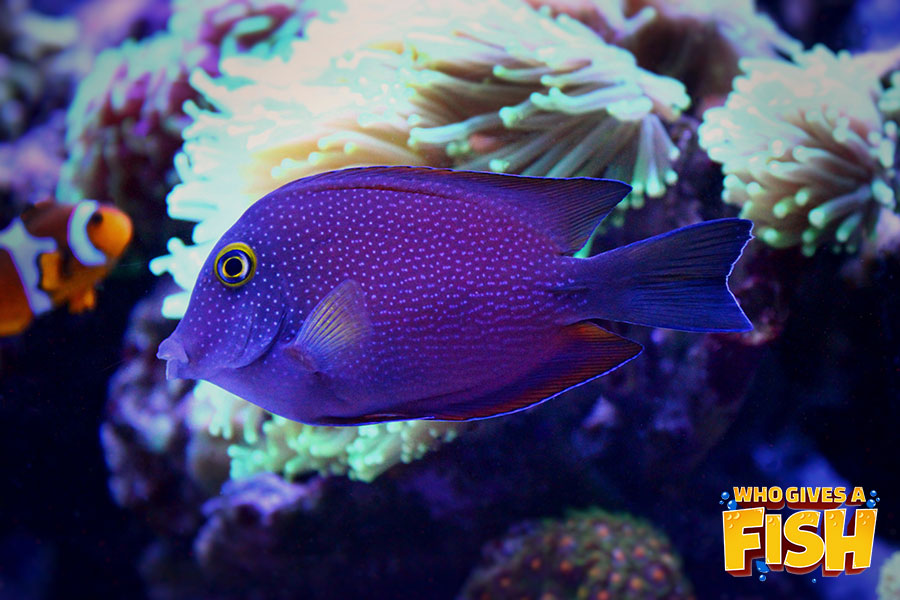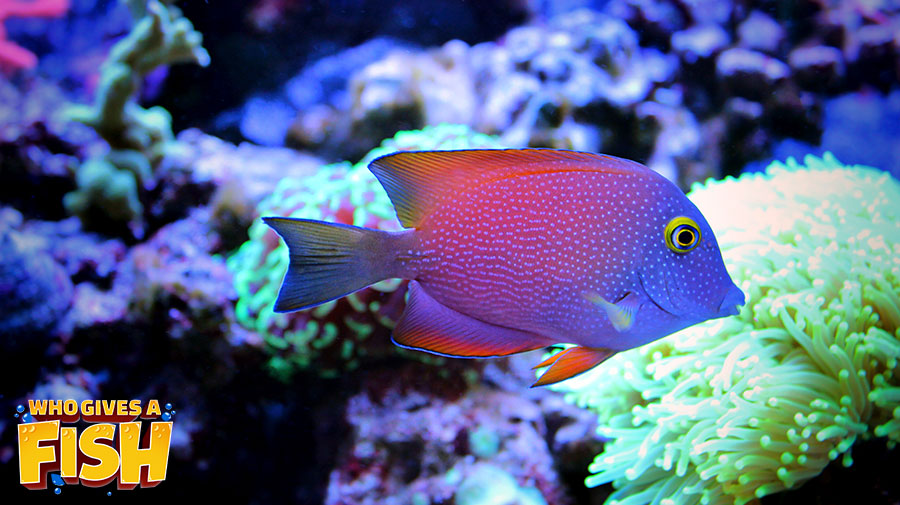Kole Tang
Like the Chevron Tang, the Kole Tang or Yellow Eyed Tang is also commonly referred to as the Comb Tooth or Bristle Tooth Tang owing to their kind of eating habits. They mainly eat detritus which comprises of small algae instead of the filamentous algae devoured by other tangs.
The Ctenochaetus breed, have numerous rows of tiny, tensile comb like teeth (Usually up to 30 teeth) combined with a pouting, bulging mouth.
- Experience Level: Moderate to Difficult
- Hardiness: Generally Hardy with adequate nutrition
- Minimum Tank Size: 75 gal (284 L)
- Size of fish: 7.1 inches (18 cm)
- Temperament: Passive
- Temperature: 73.0 to 80.0° F (23 to 27° C)
- pH Range: 8-8.4
- Diet: Herbivore
Table of Contents
Introduction
Aquarium Setup
Difficulty
Feeding
Breeding and Social
They utilize their teeth to sift and lift through numerous sorts of detrital material off of rocks, algae, sand and other surfaces and utilize their mouths to suck this food in. In the aquarium setting, you will generally see small lip marks on the glass where algae once was.
Like similar fish of its genus, the Kole Tang or Yellow-eyed Tang one of the more placid surgeonfish making it an excellent companion in a public tank. It should not be kept with hostile breeds, but rather more placid fish. It can be housed with various tank mates comprising some of the other genus’ of surgeonfish.
Its diet makes it a favorable companion for other placid surgeonfish such as the Pacific Sailfin Tang and the Yellow Tang in the Zebrasoma genus, though be sure to monitor compatibility, as it can be a focus of combative tank mates and become stressed.
Being amidst the least active and smallest of the surgeonfish, as such, one would assume a smaller aquarium would be ideal for the Kole Tang. However, as they require plenty of accumulated detritus and naturally growing food, using a little tank with live rock to aid in providing for their dietary needs, lessens their required swimming space, whereas under stocking live rock turns the tank too sterile and lessens their required food source.
For long term success in housing these fish, catering to their dietary needs is of utmost importance. To fit their dietary requirements, they will require a big aquarium with plenty of live rock. The addition of live sand will increase the levels of food. The live sand and live rock, combined with surfaces of the aquarium glass will supply plenty of areas for detritus build up and ideal algae growth to aid in accommodating this frequent feeder.
A closeup image of a Kole Tang out of the water
Aquarium Setup
This fish requires plenty of water motion, producing an oxygen rich habitat instead of a serene aquarium. Being fairly nimble, it requires a lot of swimming area, along with rocks and corals to supply crevices for hiding and sleeping at night time. It will thrive in an environment that provides coherence, not only in water quality and conditions, but also in fellow inhabitants and decor. It can be kept in a public reef setting, as it will not hurt invertebrates or corals. Live sand and live rock will bestow themselves to detritus build up and natural algae growth which this fish will happily graze on, and makes it a priceless addition to a reef setting.
Kole Tang Aquarium Guide
- Minimum Tank Size: 75 gal (284 L) – A minimum of 75 gallons is required for a single fish.
- Suitable for Nano Tank: No
- Live Rock Requirement: Yes, as live rock aids with food supply.
- Substrate Type: Any
- Lighting Needs: Any – They have no special lighting requirements though if kept with a host, the anemone will need its appropriate lighting.
- Temperature: 73.0 to 80° F (23 to 27° C)
- Specific gravity: 1.019-1.026 SG
- pH Range: 8-8.4
- Water Movement: Preferably medium to strong flow, but calmer areas for detritus and ground foods to build up.
- Water Region: All – The Kole Tang is an active swimmer and will frequent all areas of the tank.
Difficulty
Combtooth or Bristletooth Tangs are usually considered harder to tend for, but with some information of what to watch for when acquiring a specimen and by catering to its needs, you can have a prosperous experience. A few strategies for choosing a healthy fish comprise of: steering away from those with injured fins, and more importantly, those with an injured mouth. Also make sure the fish is feeding. If it nibbles on the sand and rockwork of the aquarium, it can be an excellent specimen, and also if it welcomes prepared foods.
Tangs and Surgeonfish are constant eaters, and they require a proper diet. They are susceptible to nutritive ailments which can cause LLD (lateral line disease) and color loss. Complementing their diet with a vitamin supplement added directly to their water, or the addition of vitamin C to their food, can assist in avoiding, or aid in lessening these ailments. They are also susceptible to viruses’ resultant of organic build-up, which degenerates water quality. Therefore, they require regular small water changes, vigorous filtration and protein skimming.
A few of the Acanthuridae members are extremely attractive, active and colorful to aquarists. However, they do not generate as much skin mucus on their bodies as other fish, and can be susceptible to diseases such as Marine Velvet and Marine Ich. Surgeonfish are certainly a candidate for segregation when you first acquire them. They can be cured successfully with copper drugs or medical care, but as they have a crucial microfauna in their digestive system, continuous or prolonged use of a copper treatment is not recommended.
In the wild a purer wrasse (Labroides sp.) will aid them by procuring parasites from their bodies, but these wrasses are extremely hard to maintain in captivity. Alternate fish such as Neon Gobies (Gobiosoma spp.) or purer shrimp can aid them by supplying this cleaning service.
Feeding
Although the Yellow-eyed Tangs are thought of as herbivores, in the wild they eat detritus, a slim film on the substrate that contains many nutrients including diatoms (unicellular algae), dinoflagellates (minute marine protozoans), and big portions of other organic material. In the aquarium, a majority of their diet will be acquired from grazing on the naturally growing detritus or minute algae. Yet this food source will not be adequate to sustain them, so they must also be presented supplemental foods.
Most of their diet will be vegetable matter, but they do require meaty foods occasionally as well. Make sure to provide plenty of prepared frozen formulas containing algae or spirulina, marine algae, frozen mysid shrimp and brine and flake foods.
Japanese Nori or other seaweed can be affixed to the aquarium walls with a vegetable clip. Be sure to feed 3 times a day in lesser amounts, rather than a large amount once a day. As constant grazers, they will gain from tank algae which will also maintain the water quality over a prolonged period of time.
Delivering a vitamin supplement (including vitamin C) can help their nutritional requirements, and vitamin C can aid reducing or preventing Lateral Line Erosion (LLE). This can be achieved by adding vitamins to the food, drenching dried pellets with liquid vitamins, or by adding a liquid vitamin inside the water. It is also noted that pellets dipped in garlic may aid in fending off Marine Ich. A few hobbyists also record success with supplemental foods such as leaf lettuce, spinach, previously boiled or frozen zucchini and broccoli.
Kole Tang Feeding Guide
- Diet: Herbivore – Provide additional leafy vegetables (pre cooked) or Japanese Nori in addition to the natural diet
- Flake Food: Yes
- Pellet / Tablet: Yes
- Live foods (fish, shrimp, worms): While not necessary if their is enough fish waste and detritus, live foods may be beneficial to condition them for spawning.
- Vegetable Food: 90-95% of their diet
- Meaty Food: 5-10% of their diet
- Feeding Frequency: Feed adults twice a day and juveniles 3 to 4 times a day.
Breeding
Sexual contrasts for this breed are very slight, and are problematic to detect. The male has been noted to demonstrate some color change during courtship.
A few breeds of surgeonfish have been bred in community aquariums and there have been a few disjointed reports of breeding in community aquariums, but normal rearing and breeding of the young has not been reported yet.
Although the Yellow-eyed Tang has not been bred in captivity as yet, the Ctenochaetus genus has been seen performing couple breeding in the ocean. This is the only breed from this genus that does not have a relationship with a mate, although they will also breed in pairs.
Social
The amazing thing regarding the Yellow-eyed Tang, is that they are excellent in a reef environment with corals and inverts, and they’ll graze on the algae. This is one of the more placid surgeonfish. Its calm behavior makes it an ideal companion in a public tank.
It should not be kept with hostile species, but instead more placid fish. Avoid fish of identical body shape, and those that consume a similar natural diet. In the wild adults are sole, and it should ideally be housed by itself in an aquarium setting too. It can be housed with various other tank mates comprising of some of the other genus’ of surgeonfish. The placid sailfin tangs of the Zebrasoma genus can be an ideal option as they consume a separate sort of algae, so these two tend to complement each other. If it is to be housed with any tangs, add this fish foremost and let it acclimatize prior to adding another tang.
Constantly monitor for compatibility, as the Yellow-eyed Tang can be a focus for hostile tank mates and become frazzled.
Tangs and Surgeonfish are known to be territorial, at times just with their own kind and at times with other breeds. Inserting a new surgeonfish into an aquarium that already keeps one or more is generally an issue. It is best to primarily prevent several species together, instead of adding a new one at a later date. Although a big aquarium can aid in easing a few problems, be mindful of the social behaviors of any breeds you are thinking of in order to prevent compatibility problems.





